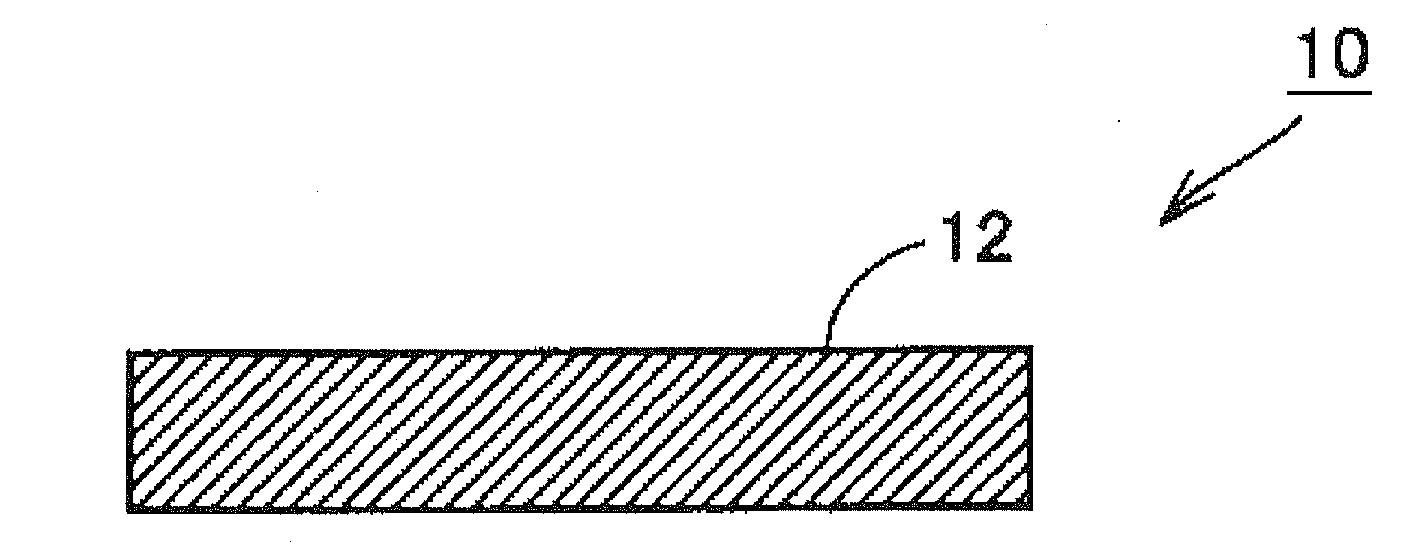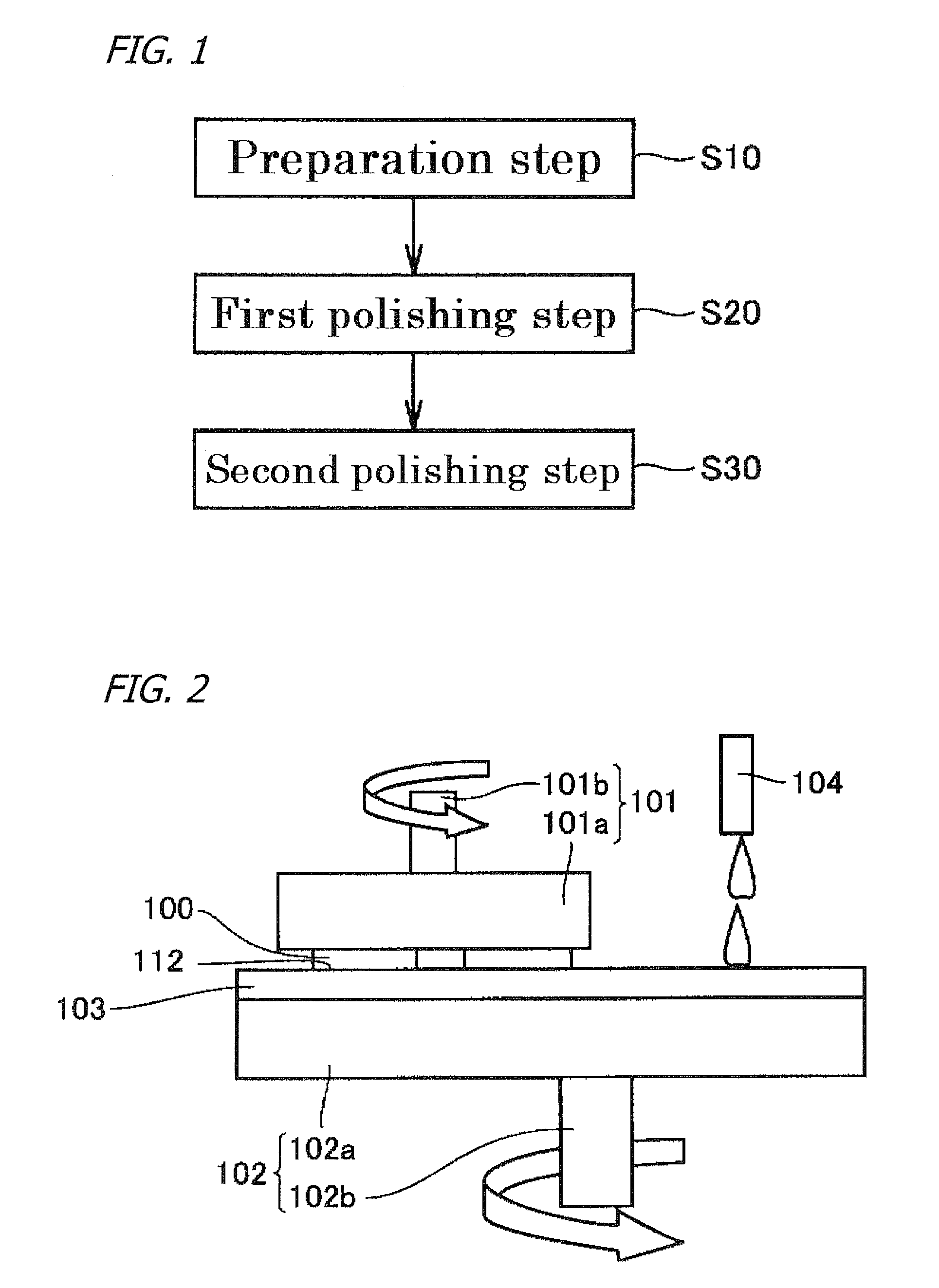Method of Polishing Compound Semiconductor Substrate, Compound Semiconductor Substrate, Method of Manufacturing Compound Semiconductor Epitaxial Substrate, and Compound Semiconductor Epitaxial Substrate
a technology of compound semiconductor and epitaxial substrate, which is applied in the direction of manufacturing tools, lapping machines, instruments, etc., can solve the problems of excessively difficult post-polishing cleaning, oxide film formation on the wafer surface, and oxide film is left on the substrate surface, so as to reduce the amount of oxygen superficially present on the substrate
- Summary
- Abstract
- Description
- Claims
- Application Information
AI Technical Summary
Benefits of technology
Problems solved by technology
Method used
Image
Examples
embodiment mode 1
[0045]FIG. 1 is a flow chart representing a method of polishing a compound semiconductor substrate in Embodiment Mode 1 of the present invention. With reference to FIG. 1, an explanation of the compound semiconductor substrate polishing method will be made.
[0046]First, as represented in FIG. 1, a preparation step (S10) is carried out, in which a compound semiconductor substrate is prepared. In the preparation step (S10), the compound semiconductor substrate composed of gallium arsenide, indium phosphorus, indium antimony, gallium antimony, indium arsenide, gallium nitride, indium nitride, and aluminum nitride is preferably prepared. It should be understood that the compound semiconductor substrate to be prepared may be a bulk crystal or a thin film formed on a substrate composed of, for example, the bulk crystal.
[0047]Next, as represented in FIG. 1, a first polishing step (S20) is carried out, in which the compound semiconductor substrate is polished with a chloric polishing agent. ...
embodiment mode 2
[0067]FIG. 4 is a flow chart representing a method of surface treating the compound semiconductor substrate in Embodiment Mode 2 of the present invention. Referring to FIG. 4, the compound semiconductor-substrate surface treating method in Embodiment Mode 2 of the present invention will be described. As represented in FIG. 4, the compound semiconductor-substrate surface treating method in Embodiment Mode 2 has steps similar to those of the compound semiconductor-substrate polishing method in Embodiment Mode 1, but differs only in comprising a pre-treatment step (S50), pre-cleaning step (S60), and a cleaning step (S70).
[0068]First, as illustrated in FIG. 4, the preparation step (S10) of preparing the compound semiconductor substrate is carried out as in Embodiment Mode 1.
[0069]Next, prior to the first and second polishing steps (S20, S30), pre-treatment step (S50) is carried out, in which the compound semiconductor substrate is polished. In the pre-treatment step (S50), before the fi...
embodiment mode 3
[0078]FIG. 6 is a flow chart representing a compound semiconductor epitaxial-substrate manufacturing method of the Embodiment Mode 3 of the present invention. Referring to FIG. 6, the compound semiconductor epitaxial-substrate manufacturing method will be described. The compound semiconductor epitaxial-substrate manufacturing method comprises basically steps similar to those of the compound semiconductor substrate polishing method in Embodiment Mode 1, but differs only in carrying out the post-treatment step (S40) of forming on the front side 12 of the compound semiconductor substrate 10 an epitaxial layer 21.
[0079]Specifically, first, as illustrated in FIG. 6, the compound semiconductor substrate polishing method (S10 to S30) is carried out.
[0080]Next, the post-treatment step (S40) is carried out, in which the epitaxial layer is formed on the front side of the compound semiconductor substrate 10. It should be understood that the compound semiconductor substrate used in the post-tre...
PUM
| Property | Measurement | Unit |
|---|---|---|
| pH | aaaaa | aaaaa |
| RMS roughness | aaaaa | aaaaa |
| RMS roughness | aaaaa | aaaaa |
Abstract
Description
Claims
Application Information
 Login to View More
Login to View More - R&D
- Intellectual Property
- Life Sciences
- Materials
- Tech Scout
- Unparalleled Data Quality
- Higher Quality Content
- 60% Fewer Hallucinations
Browse by: Latest US Patents, China's latest patents, Technical Efficacy Thesaurus, Application Domain, Technology Topic, Popular Technical Reports.
© 2025 PatSnap. All rights reserved.Legal|Privacy policy|Modern Slavery Act Transparency Statement|Sitemap|About US| Contact US: help@patsnap.com



